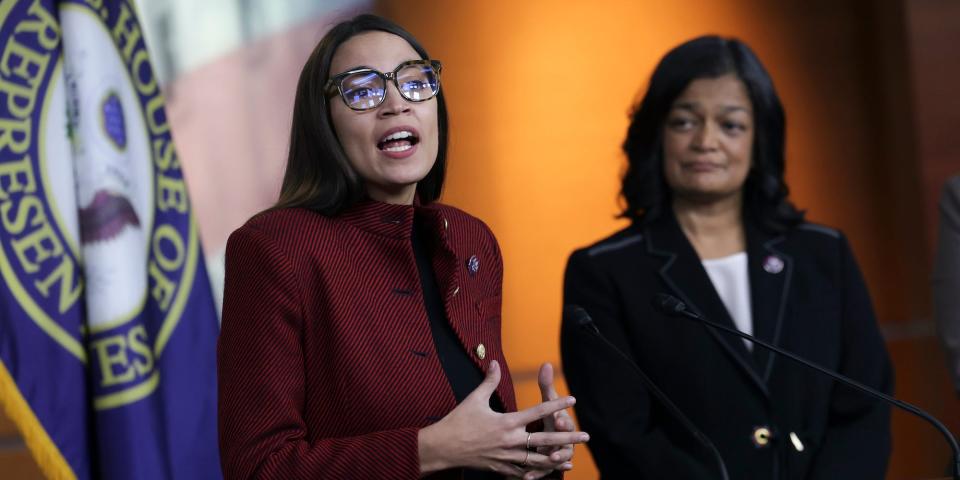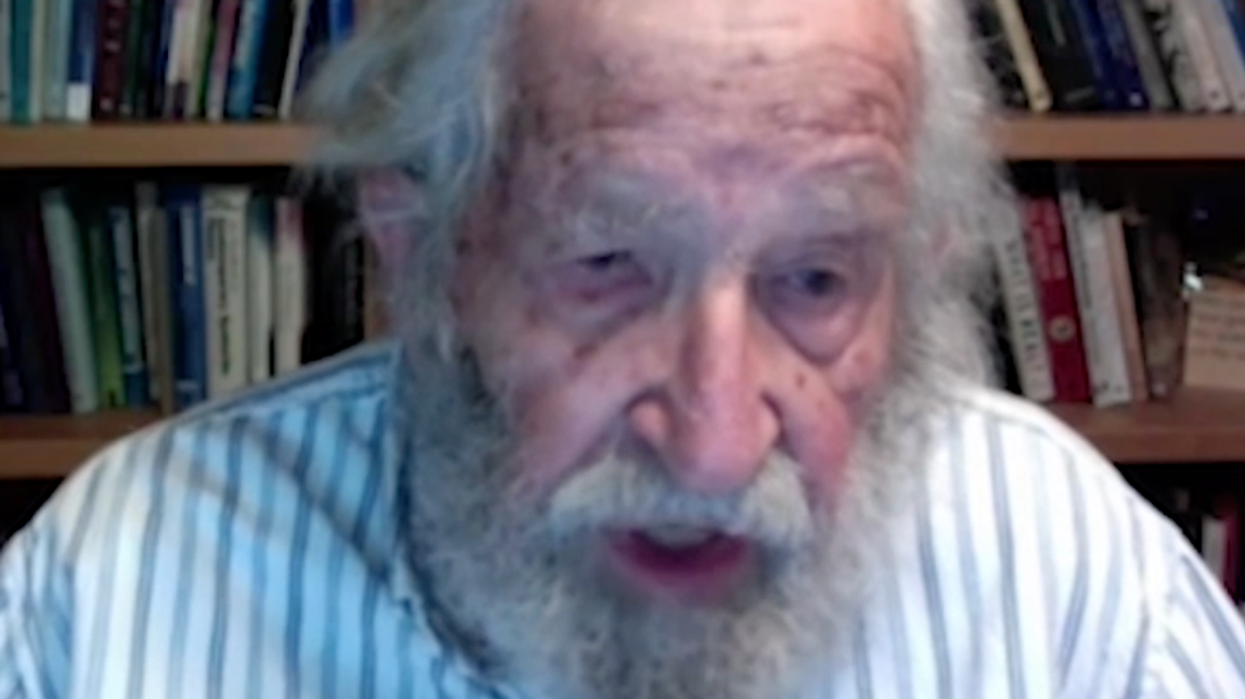NOT BEING DEPORTED
Embracing Ukrainians At The US-Mexico BorderBy Paula RAMON
04/10/22
Oleksii Yeromin stands at the gate on the US-Mexico border and calls to Ukrainian migrants crossing into America after fleeing the war in their home country, then wraps them in a hug on the other side.
"Come here, come, you see this line? Here there's the last checkpoint to go through and you will be in the United States," he said in English.
Wearing a hat and carrying a blue and yellow Ukrainian flag, the 43-year-old is the first face that many Ukrainians see as they cross into the United States.
He has even marked that final step for them, tracing the letters "USA" on the ground in red tape.
"Ukraine welcomed me, now Ukraine needed me here,"says Yeromin, who is originally from Uzbekistan and emigrated several years ago to Ukraine, where he married and had two daughters.
Five years ago he decided to go to Chicago to seek a better future. This week he was reunited with his wife and daughters at the US-Mexico border. They, too, had fled the war.
Family is everything, he said. "Any money, any house, anything's doesn't matter. It's zero." He is red-eyed -- likely from the exhaustion of not having slept more than four hours a night for days now.

Oleksii Yeromin, wrapped in a Ukrainian flag, hugs a refugee as they cross the San Ysidro PedWest port of entry along the US-Mexico border between Tijuana, Baja California, and the US on April 8, 2022 in San Ysidro, California
Photo: AFP / Patrick T. FALLON
Even after welcoming his family, the painter by trade decided to stay at the gate.
"This is minimum. They travel long, they need a hug," he said.
His eldest daughter, Katarina, 13, does not speak English, but she helps out at the care center that has been set up as part of a massive volunteer operation.
"I'm very happy because I met my dad and also for helping here," says Katarina with the help of Gisele, her new friend and interpreter.
Soon, she is handing a phone battery to a young man and offering lollipops to a little girl.
"I'm very excited. I'm privileged, lucky. I needed to give back," adds the teenager with a shy smile.
"You made it, you're here. Come here, come here," says Yeromin a few meters away, while giving out more hugs.
Even after welcoming his family, the painter by trade decided to stay at the gate.
"This is minimum. They travel long, they need a hug," he said.
His eldest daughter, Katarina, 13, does not speak English, but she helps out at the care center that has been set up as part of a massive volunteer operation.
"I'm very happy because I met my dad and also for helping here," says Katarina with the help of Gisele, her new friend and interpreter.
Soon, she is handing a phone battery to a young man and offering lollipops to a little girl.
"I'm very excited. I'm privileged, lucky. I needed to give back," adds the teenager with a shy smile.
"You made it, you're here. Come here, come here," says Yeromin a few meters away, while giving out more hugs.
A massive US-Mexican effort to welcome Ukrainian refugees

Volunteers with signs welcome Ukrainian refugees as they arrive at the Tijuana, Mexico airport on their way to the US
Anastasia Chorna, 15, holds a stuffed shark while waiting in a converted sports center in Tijuana, Mexico; she and her mother had fled the war in Ukraine, but her father had to remain behind

Volunteers Liza Melnichuk (C) and Maria Melnichuk, 26-year-old twins, wait at an arrival area at the Tijuana airport to welcome arriving Ukrainian refugees


Paula RAMON
Sun, 10 April 2022
Nadiya Ruyhynska had almost never left Ukraine, though her daughter lives in the US city of Seattle.
But with the war looming in her hometown of Lviv, the 55-year-old former nurse set off on the long journey to the Mexican city of Tijuana, where a massive operation is helping thousands of Ukrainian refugees cross the border to resettle in the United States.
Most arrive with mixed emotions.
"I am 50-50," said the former nurse as she stepped onto American soil.
"I have happiness" at the prospect of being reunited with her pregnant daughter Christina, who has a young son, but also sadness at having left her own mother behind, she said.
Like Ruyhynska, hundreds of Ukrainians have reached the border town of Tijuana in hopes of crossing onto US soil -- encouraged by a promise from Washington that it is prepared to welcome up to 100,000 Ukrainians who have fled the war.
Pavel Savastyanov, a Russian-born volunteer helping at a support center for Ukrainians in San Ysidro, California, just across the border from Tijuana, said every flight to the area is bringing more.
- 'The first step' -
The operation begins at Tijuana International Airport. The first thing passengers see when they pass through the arrival gate is a blue-and-yellow Ukrainian flag next to signs in Cyrillic reading "Welcome" and "Help."
In a small office there, volunteers record the new arrivals' names on a list -- already bearing more than 2,300 names -- for eventual transportation to the border.
"This is the first step," said Sergio, a 36-year-old Ukrainian volunteer who declined to give his last name. He and his cousin had traveled 500 miles (800 kilometers) from Sacramento, the California capital, to help the arriving refugees.
One area in the airport is marked off with yellow tape. A sign in English and Spanish reads: "Ukrainian refugees only."
There is food and drinks, and a play corner set aside for children with crayons and coloring books.
From there, the refugees are taken to one of four housing centers that volunteers, with governmental and church support, quickly set up in this city that has long drawn thousands of Latin Americans hoping to reach the United States.
- 'My dad had to stay' -
"My dad had to stay behind," said 15-year-old Ukrainian Anastasia Chorna, choking back tears.
Sitting in a chair in the Benito Juarez sports complex, Tijuana's largest refugee center for Ukrainians, she hugged the enormous stuffed gray shark she had brought when she and her mother left home.
"It's literally the only thing I could bring," she said.
Her father, who is 41, remains in Kyiv. "I feel bad because I wanted him to be here, with these volunteers, where everything is so peaceful," Anastasia said, struggling to express herself in a language not her own.
She and her mother had passed through four countries on the long way to Mexico, where getting a visa for entry is comparatively easier for Ukrainians than to the United States.
Some men did flee Ukraine, in violation of a martial-law decree requiring all those aged 18 to 60 to stay and fight or face conscription.
"I know I committed a crime, but I didn't want to fight," said a 25-year-old engineer, who refused to give his name.
He had left Ukraine with his partner, whom he married the day war broke out, and was now waiting for his number to be called for a bus to the US border.
"I've never picked up a gun... I couldn't kill someone or watch them die. I couldn't," he said, crestfallen, in broken English.
For those who speak no English, an enormous network of volunteers is there to help.
- Growing numbers -
Twins Maria and Liza Melnichuk had emigrated with their family from Ukraine 20 years ago.
When the sisters, now 26, heard about the influx of refugees, they jumped into their car to drive the 540 miles to Tijuana to join an active rotation of volunteers working round-the-clock. As Ukrainian-speakers, they knew they could help.
"We're glad to see the people arrive," said Liza, who was able to welcome her cousins who had fled Bucha, the Ukrainian town now synonymous with charges of extreme brutality under Russian occupation.
Her sister Maria said the numbers of arrivals have been steadily growing. "On Wednesday we received some 300 people, and already today (Friday) there must have been 700."
A coordinated effort between Mexican and US authorities made the so-called Ped West entrance at the border exclusively available for the arrivals.
Buses transport hundreds of people a day to a line where they are received by Mexican officials before crossing on foot to the US side.
Once on Californian soil, the tears flow -- of joy and of sadness.
"I don't think there are words to describe what has happened, and how hard it has been," said Christina Ruyhynska after a long, emotional hug with her mother -- their first in three years.
The two women, wiping away tears, spoke briefly in Ukrainian.
Then in English, Christina turned to her mother and asked, "Are you ready to go home?"
pr/dl/bbk/sw/dw

Volunteers with signs welcome Ukrainian refugees as they arrive at the Tijuana, Mexico airport on their way to the US

Anastasia Chorna, 15, holds a stuffed shark while waiting in a converted sports center in Tijuana, Mexico; she and her mother had fled the war in Ukraine, but her father had to remain behind

Volunteers Liza Melnichuk (C) and Maria Melnichuk, 26-year-old twins, wait at an arrival area at the Tijuana airport to welcome arriving Ukrainian refugees

Three-year-old Anna Kuts sleeps on a suitcase after arriving with her family at the Tijuana, Mexico airport, where an army of volunteers is helping Ukrainian refugees near the end of their long voyage to the United States

Nadiya Ruyhynska (R) hugs her daughter Christina after crossing into the US from Tijuana, Mexico at the end of a long journey from Ukraine; she was one of thousands of Ukrainians entering the US from Tijuana
PHOTOS (AFP/Patrick T. FALLON)
Paula RAMON
Sun, 10 April 2022
Nadiya Ruyhynska had almost never left Ukraine, though her daughter lives in the US city of Seattle.
But with the war looming in her hometown of Lviv, the 55-year-old former nurse set off on the long journey to the Mexican city of Tijuana, where a massive operation is helping thousands of Ukrainian refugees cross the border to resettle in the United States.
Most arrive with mixed emotions.
"I am 50-50," said the former nurse as she stepped onto American soil.
"I have happiness" at the prospect of being reunited with her pregnant daughter Christina, who has a young son, but also sadness at having left her own mother behind, she said.
Like Ruyhynska, hundreds of Ukrainians have reached the border town of Tijuana in hopes of crossing onto US soil -- encouraged by a promise from Washington that it is prepared to welcome up to 100,000 Ukrainians who have fled the war.
Pavel Savastyanov, a Russian-born volunteer helping at a support center for Ukrainians in San Ysidro, California, just across the border from Tijuana, said every flight to the area is bringing more.
- 'The first step' -
The operation begins at Tijuana International Airport. The first thing passengers see when they pass through the arrival gate is a blue-and-yellow Ukrainian flag next to signs in Cyrillic reading "Welcome" and "Help."
In a small office there, volunteers record the new arrivals' names on a list -- already bearing more than 2,300 names -- for eventual transportation to the border.
"This is the first step," said Sergio, a 36-year-old Ukrainian volunteer who declined to give his last name. He and his cousin had traveled 500 miles (800 kilometers) from Sacramento, the California capital, to help the arriving refugees.
One area in the airport is marked off with yellow tape. A sign in English and Spanish reads: "Ukrainian refugees only."
There is food and drinks, and a play corner set aside for children with crayons and coloring books.
From there, the refugees are taken to one of four housing centers that volunteers, with governmental and church support, quickly set up in this city that has long drawn thousands of Latin Americans hoping to reach the United States.
- 'My dad had to stay' -
"My dad had to stay behind," said 15-year-old Ukrainian Anastasia Chorna, choking back tears.
Sitting in a chair in the Benito Juarez sports complex, Tijuana's largest refugee center for Ukrainians, she hugged the enormous stuffed gray shark she had brought when she and her mother left home.
"It's literally the only thing I could bring," she said.
Her father, who is 41, remains in Kyiv. "I feel bad because I wanted him to be here, with these volunteers, where everything is so peaceful," Anastasia said, struggling to express herself in a language not her own.
She and her mother had passed through four countries on the long way to Mexico, where getting a visa for entry is comparatively easier for Ukrainians than to the United States.
Some men did flee Ukraine, in violation of a martial-law decree requiring all those aged 18 to 60 to stay and fight or face conscription.
"I know I committed a crime, but I didn't want to fight," said a 25-year-old engineer, who refused to give his name.
He had left Ukraine with his partner, whom he married the day war broke out, and was now waiting for his number to be called for a bus to the US border.
"I've never picked up a gun... I couldn't kill someone or watch them die. I couldn't," he said, crestfallen, in broken English.
For those who speak no English, an enormous network of volunteers is there to help.
- Growing numbers -
Twins Maria and Liza Melnichuk had emigrated with their family from Ukraine 20 years ago.
When the sisters, now 26, heard about the influx of refugees, they jumped into their car to drive the 540 miles to Tijuana to join an active rotation of volunteers working round-the-clock. As Ukrainian-speakers, they knew they could help.
"We're glad to see the people arrive," said Liza, who was able to welcome her cousins who had fled Bucha, the Ukrainian town now synonymous with charges of extreme brutality under Russian occupation.
Her sister Maria said the numbers of arrivals have been steadily growing. "On Wednesday we received some 300 people, and already today (Friday) there must have been 700."
A coordinated effort between Mexican and US authorities made the so-called Ped West entrance at the border exclusively available for the arrivals.
Buses transport hundreds of people a day to a line where they are received by Mexican officials before crossing on foot to the US side.
Once on Californian soil, the tears flow -- of joy and of sadness.
"I don't think there are words to describe what has happened, and how hard it has been," said Christina Ruyhynska after a long, emotional hug with her mother -- their first in three years.
The two women, wiping away tears, spoke briefly in Ukrainian.
Then in English, Christina turned to her mother and asked, "Are you ready to go home?"
pr/dl/bbk/sw/dw













/cdn.vox-cdn.com/uploads/chorus_image/image/70722642/GettyImages_1186605531.0.jpeg)
:no_upscale()/cdn.vox-cdn.com/uploads/chorus_asset/file/23372992/VRG_Data_5131_DAC_01.png)
:no_upscale()/cdn.vox-cdn.com/uploads/chorus_asset/file/23372995/VRG_Data_5131_DAC_02.png)
:no_upscale()/cdn.vox-cdn.com/uploads/chorus_asset/file/23372997/VRG_Data_5131_DAC_03.png)
